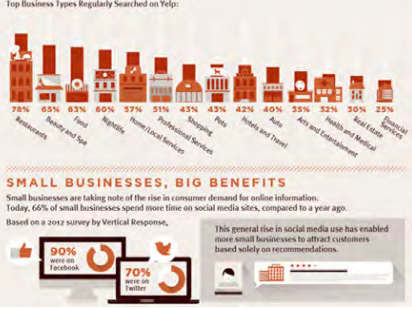13.4: Core principles
- Page ID
- 24938
Social media consists of a vast number of different platforms, most of which have different rules for what will and will not work well as an advertisement. However, there are some general principles that govern social media advertising as a whole.
General guidelines
First, remember that 80% of social media time takes place on mobile devices (comScore, 2016). This means that any ad you create for social media is highly likely to be viewed on mobile so you need to make sure that it will look good on that device. Test your posts on mobile devices before you pay to promote them. Consider:
- Images should be clear and convey meaning even when small.
- Text should be brief enough to minimise the need for scrolling.
- The point of the ad should come across immediately with a clear CTA.
- Any links in the ad should lead to mobile-optimised landing pages.
Second, most content on social media is user-generated so if you’re creating paid ads, you need to match the rules of the platform you’re on and generate content that fits what users of that platform will expect. Make sure you understand the platform before you start advertising on it.
As an example of matching content to platform, take a look at Denny’s, an American restaurant chain, on Tumblr.

Compare their tone on Tumblr to their tone on Facebook, which, while still informal and friendly, is much more in line with the slightly more professional feel expected by users of that platform.


Similarly, compare Wendy’s, an American fast-food chain, tone on Twitter to their tone on Facebook.
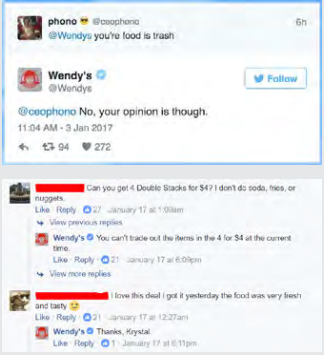
While promoted ads aren’t the same thing as responding to customers, the same principle applies: fit your tone and content to the platform. On Facebook, because reading the audience can be a little difficult, because their audience is so broad, a more neutral, but still brand-relevant, tone is best. On other platforms, because you can see more about the users you are speaking to, it can be easier to adapt your tone to them. Remember, though, that your tone should also be informed by your brand identity and overarching strategy.
Third, use your regular, unpaid posts to test out your paid ads. Make sure that you use effective social media copy in every post. Keep your copy short and to the point, with a clear call to action that tells the reader exactly what to do next, and give them a reason to click or carry out the CTA. Then, track which posts are being liked, shared, or commented on, those should be your first choice for paid promotion. The feedback you get on posts is often near-instantaneous, so this will allow you to respond quickly to whichever posts are doing well and which are doing badly. Facebook Ads Manager can help you do A/B testing by putting equal funds behind two different posts. The one that gets a better initial response gets the rest of the funds.
Fourth, rotate ads often. Social media users expect fresh content; they should not be seeing the same ad multiple times over multiple days, so rotate ads every three to five days (Hootsuite, 2016a). The general rule is that a user should see an ad a maximum of four times.
Payment models
Read more about payment models in the Online advertising chapter.
You should be familiar with the various payment models available from the Online advertising chapter.
The most likely payment models you will encounter on social media include:
- CPC (Cost per click, pay only when the ad is clicked on)
- CPE (Cost per engagement, pay only for demonstrated engagement with the ad)
You can learn more about Facebook’s oCPM bidding here: blog. adstage.io/2014/06/16/ learn-about-facebookocpm-bidding.
- CPM (Cost per thousand impressions)
- oCPM (Optimised cost per mille, Facebook’s flexible ad bid type, where bids can be adjusted based on the goals the advertiser hopes to achieve).
Other payment models will be encountered on other platforms, for example, Pinterest uses an auction bid model for its CPM. Users set a maximum price, but are only charged the amount needed to top the second-highest bidder. They are then charged per thousand views. As another example, a lot of specialised paid media on Twitter is done via third parties like Ad Dynamo and can require high budgets and one-off costs rather than being cost per view or engagement.
Platforms
One of the core principles to keep in mind when choosing a social media platform on which to advertise is that you need to go where your audience is. Be sure to choose a platform that fits your needs as a business as well. Let’s take a look at a few of the most popular platforms to see what they can offer and why you might want to focus your attention on them. Note that the demographic statistics given are for the US. As you read, keep in mind that for most networks, the number of older users is increasing which can lead to changes in the behaviour of younger users on the platform or even drive them off entirely.
Learn more about the popular platforms in the Social media platforms chapter.
What they offer: Facebook offers a wide array of targeting options and the biggest social media audience in the world, with 1.79 billion users as of the third quarter of 2016 (Statista, 2016). Ad formats are based on desired objectives (which we will discuss in the next section). Their pricing can vary significantly based on a number of factors, but their ad platform is fairly intuitive, and Facebook Analytics gives you a lot of information you can use to optimise ad performance.
You will have access to Facebook Ads Manager, which allows you to manage campaigns, ad sets, and individual ads. This is also available as an app.
Who uses it: 83% of female-identified and 75% of male-identified Internet users use Facebook. The demographics are skewed toward the youth market, with 88% of 18 to 29-year-olds, 84% of 30 to 49-year-olds, and 62% of online users aged 65 and up using the platform 82% of users have some form of higher education (Sprout Social, 2017).

Best suited to: Every business should have a Facebook page, as it is the bare minimum of what users expect. Your business should be on Facebook even if it is just listed with an address, website, and other basic details. Whether a business should use paid advertising to promote posts depends on what it wants to achieve, but if you plan to use social media advertising at all, you should consider starting on Facebook.
What they offer: Instagram offers photo, video and carousel ads in a number of formats. Because it is owned by Facebook, it has many of the same features, including analytics (through Facebook Ads Manager), good targeting options, and various objectives to drive campaigns. Instagram stories is also a powerful feature, which is mentioned in the Social media platforms chapter. Finally, Instagram is potentially the best platform at the moment to work with influencers. It has a very tight community culture with a focus on quality, unique content and creativity.
Who uses it: More women use Instagram than men, and more people in urban areas use it than in rural areas. Income is split fairly evenly among various income brackets, with 38% of users earning more than US $75 000 annually active on the platform. The important thing to note for Instagram is age, 59% of users between 18 and 29 use Instagram, compared to only 8% above 65 (Sprout Social, 2017).

Best suited to: In theory, any business can use Instagram. The key attraction for Instagram is visually attractive pictures and videos, so businesses that lend themselves to visuals like this, such as food, decoration, or travel-related brands, will have an advantage, but any business that wants to capture that all-important 18−24 year-old demographic should be active here.
What they offer: Twitter offers ad campaigns based on objectives, much like Facebook and Instagram, and the kind of targeting you would expect from a major social media platform. Many marketers point out that advertising on Twitter is a problem because the ads are expensive, the targeting is not as good as Facebook’s, and user growth has stalled, but pay-per-click (PPC) on Twitter can be cheaper than other options.
Read more about payment models such as PPC in the Online advertising and Search advertising chapters.
Followers earned from a Twitter campaign tend to be fairly qualified prospects. They will have been chosen to see your tweets based on how well they fit your targeting profile, and they then choose to follow you based on how well your tweet speaks to their needs.
Who uses it: Twitters users are also skewed towards the youth market, 36% of adults aged 18 to 29, but only 10% of adults over 65, use it. And there is an equal percentage of men and women active on the platform. For location, 77% of Twitter accounts are from outside the US, with a fairly even distribution across urban, suburban and rural areas. Like Facebook, college graduates make up the largest audience for Twitter, 54% have some tertiary education or have graduated college. The income demographics are very similar to Instagram, with 30% of adults who earn more than US $75 000 a year using Twitter (Sprout Social, 2017).
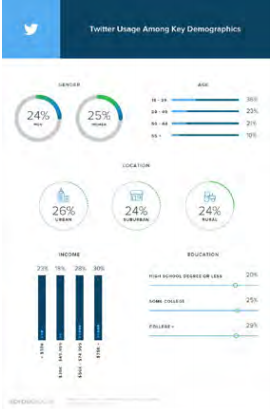
Best suited to: Any business that wants to reach an audience like the one described. Twitter audiences are used to instant gratification, Twitter feuds (check out the hashtag #cuteanimaltweetoff for a good example of this), and snappy comebacks. Twitter is a highly politicised space, so any slip-ups or faux pas on the part of your brand will be quickly picked up.
What they offer: Most social media sites offer good targeting options, but in keeping with its position as a social network for business professionals, LinkedIn’s targeting options involve someone’s professional abilities. It also tends to convert well on gated content that requires users to enter an email address or other information to download something.
Who uses it: Until 2017, LinkedIn was one of the few social networks that didn’t skew toward 18−29 year olds, however this shifted in 2017.
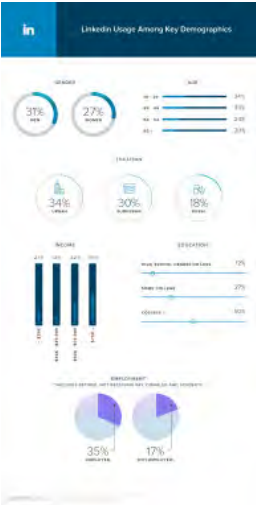
LinkedIn is used by:
- 34% of adults 18−29
- 33% of adults 30−49
- 24% of adults 50−64
- 21% of adults over 65.
More men than women use LinkedIn, 31% to 27%. On the LinkedIn press page, you can see a map of all their users.

LinkedIn is even more focused on users with some tertiary experience, 50% of adult college graduates and 27% of adults with some college experience use it. Higher levels of users are high earners, with 45% of adults making over US $75 000 using the platform (Sprout Social, 2017).
Best suited to: B2B marketers who want to target business professionals should start with LinkedIn, and companies that hire a lot of people.
What they offer: Pinterest doesn’t offer as many targeting options as some other social media platforms, but it still has basic location, device, gender, and language targeting. Users often visit Pinterest specifically to gather information about and plan potential purchases, and those who view ads on Pinterest tend to have greater awareness and purchase intent than those who do not.
Who uses it: Pinterest is a great platform for targeting women. 45% of women use it, while only 17% of men do. It is again skewed toward the younger market, with 36% of adults 18−29 using it, dropping steadily as age increases. Only 16% of adults aged 65+ use the platform. Pinterest is most popular in suburban areas, 34% of people living in suburban areas use it, while 30% of urban users are active. Like many social media platforms, its users tend to have at least some tertiary education (Sprout Social, 2017).

Best suited to: Retailers tend to make the most use of this platform, though other businesses can create successful accounts as well. The key is to create beautiful, useful boards that people want to look at, and use advertising to capitalise on that.
Snapchat
What they offer: Snapchat is one of the newer major social networks, but it has come a long way since its origin as a niche platform mostly used by teenagers. It still has a lot of pull with young demographics, and it encourages real-time content creation and consumption, with users paying more attention to content. Most video snaps are watched with audio on, which differs greatly from Facebook, and Snapchat has an engagement rate five times higher than the average clickthrough rate for other platforms (Wallaroo Media, 2017). Facebook, Instagram and WhatsApp have been fairly blatant about stealing Snapchat’s features, including Stories and Filters, which could mean a drop-off in users over time. However, Snapchat is fighting back with new offerings such as Lenses.
Who uses it: Snapchat is dominated by younger users, with 60% of users under 25. About 23% of users haven’t yet graduated from high school. Only about 12% of users are aged 35 to 54, with a mere 2% of users aged 65+. However, this is changing, more than half of new users signing up to Snapchat are over 25. Snapchat doesn’t publish gender information for its users, but in 2013, about 70% of users were women, and a survey from 2015 showed that more women than men use the platform (Hootsuite, 2016b). The highest penetration rate for Snapchat is in Ireland, then Saudi Arabia and Sweden. College students are more likely to have Snapchat accounts than other demographic groups.
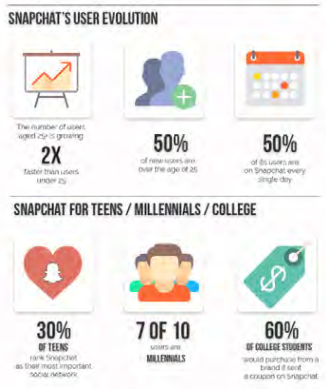
Best suited to: Snapchat has fewer options for small businesses than most other social media platforms simply because their options are expensive. Prices have come down, however, with cheapest option, the Sponsored Local Geofilters ad, coming in at as little as US $5. This means that, while the bigger options are still only available to big businesses, other options are available to almost anyone. This means that Snapchat is suited to any business that wants to find a particularly young audience.
Yelp
What they offer: Yelp is a review site that helps users select a business that suits their needs. There are many sites similar to Yelp, so keep in mind that you may want to choose a different option that is more active in your area. Tracking leads generated by Yelp can be difficult, but it does provide some metrics like page views and ad clicks. With users relying more and more on reviews and review sites when choosing where to buy, platforms like Yelp are increasingly attractive.
Who uses it: Men use Yelp more than women, and women are 50% less likely to leave a review if they use the site regularly. People in urban areas are twice as likely as those in rural or suburban areas to use Yelp to choose a business. Yelp users are active on mobile, with 71% of searches on the platform originating from mobile devices worldwide. The largest age demographic for Yelp users is 18−34, which accounts for almost 42% of Yelp users. Most users, 60%, have at least some college education, and 38% of users have an annual household income of at least US $100 000 (Gaille, 2015).
Best suited to: Yelp works best for location-based businesses. That said, many advertisers argue that advertising on Yelp may not be worth the money compared to a free profile so weigh your options carefully.
